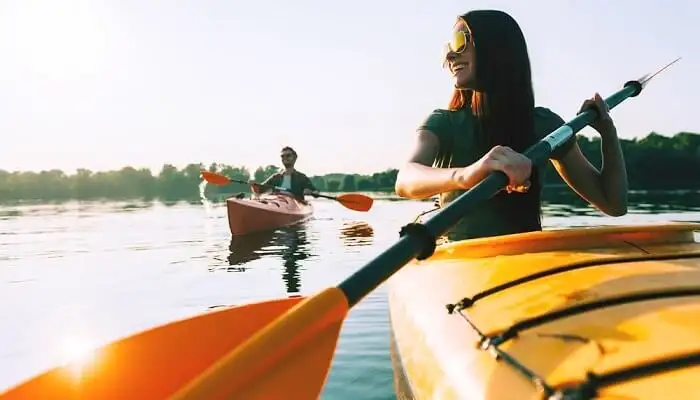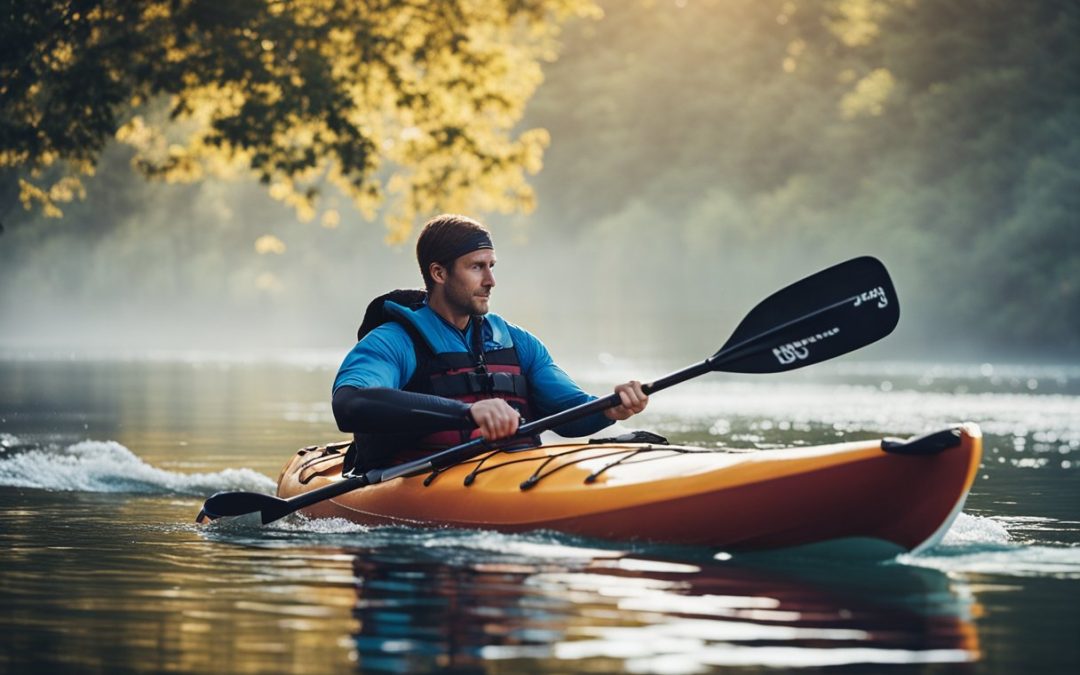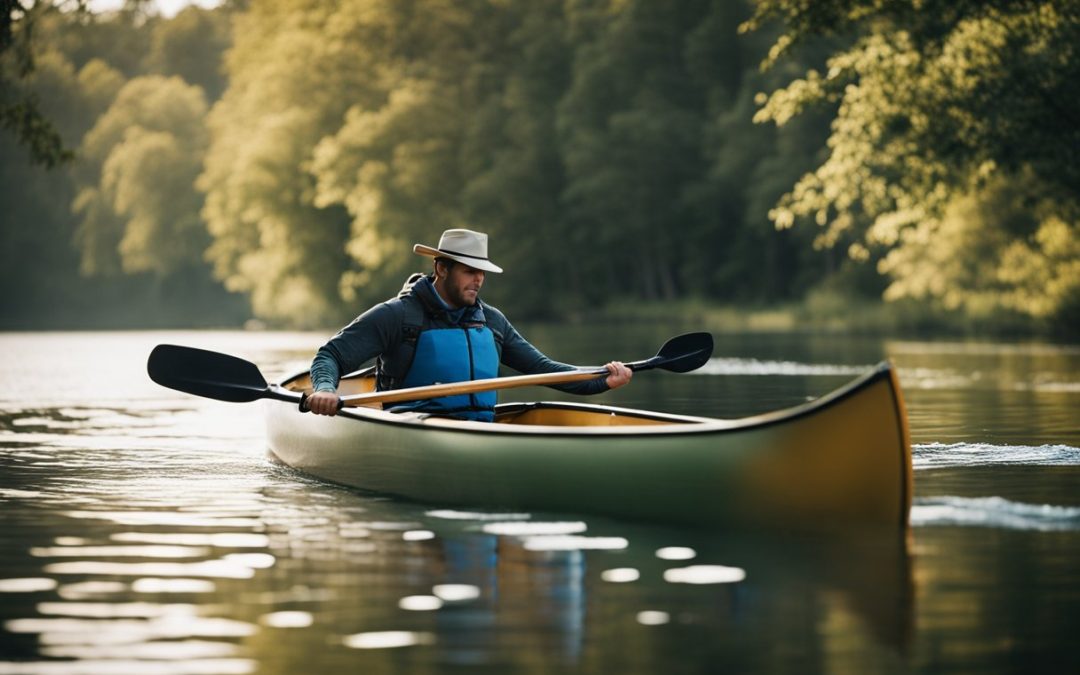Proper kayak equipment inspection is essential to ensure the safety and performance of your kayak, paddles, and personal gear. Regularly checking your kayak and its equipment can identify potential issues before they lead to a hazardous situation, ensuring a safer and more enjoyable experience on the water.
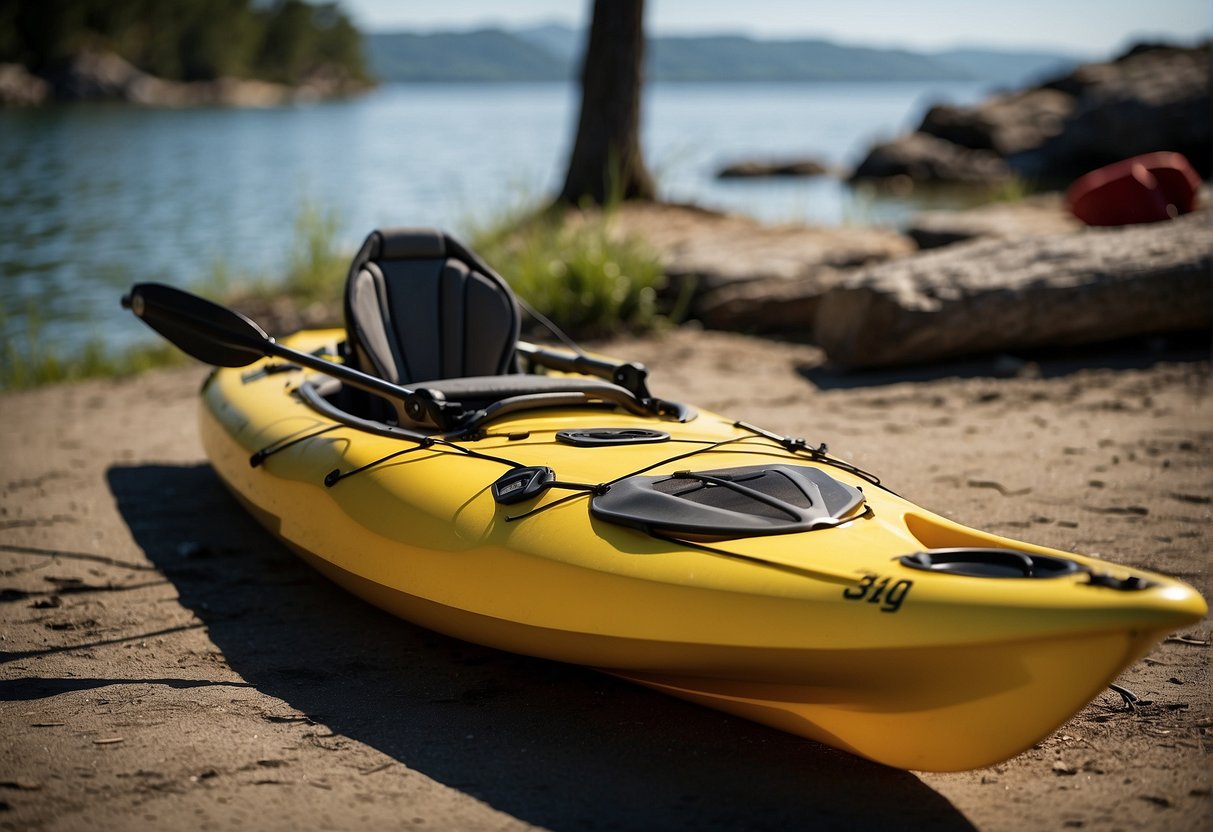
Understanding the construction and complexity of your kayak is an essential part of the inspection process. Assessing your equipment thoroughly and following a systematic approach not only minimizes the risk of accidents but also prolongs the lifespan of your kayak.
Awareness of the unique challenges of kayaking in different water environments and weather conditions is critical. By incorporating a kayak maintenance schedule, you can keep your equipment in top condition and be prepared for the unexpected, resulting in a safer and more satisfying paddling adventure.
Key Takeaways
- Regular inspection of kayak equipment ensures safety and prolongs the lifespan of your gear.
- A systematic approach to equipment assessment caters to different water environments and weather conditions.
- Maintaining a maintenance schedule and being prepared for emergencies result in a safer kayaking experience.
Understanding Kayak Construction
Materials and Design Variations
Kayaking is a popular water-based recreational activity. A kayak’s overall performance, durability, and safety largely depend on its construction. As such, it is essential to understand the variety of available materials and designs. Kayaks are commonly made from fiberglass, polyethylene, and composite materials. Plastic kayaks are usually more affordable and durable, making them ideal for beginners. Due to its durability and affordability, polyethylene is the most widely used plastic material for kayak construction.
On the other hand, composite kayaks use a combination of materials like fiberglass, carbon fiber, or Kevlar. These kayaks are lighter and more responsive but tend to be more expensive. Fiberglass is a popular choice for composite kayaks because it offers excellent strength and stiffness while keeping the weight low.
Some common design variations include:
- Sit-on-top kayaks
- Sit-inside Kayaks
- Inflatable Kayaks
- Fishing Kayaks
- Whitewater Kayaks
Kayak Hull and Structure
A kayak’s hull is the primary component that determines its performance, stability, and maneuverability. The hull’s design significantly dictates how a kayak will behave in different water conditions and for other purposes.
There are two primary aspects of hull design:
Rocker refers to the curvature of the keel and hull from bow to stern. A kayak with a high rocker will have a “banana-like” shape, making it easier to maneuver in the water and more suitable for navigating waves or white water conditions.
Chine: The transition between the bottom of the kayak and its sidewalls can be soft or hard. A hard chine will have a sharper angle, improving secondary stability, wherein the boat is more stable when leaning onto its side. Soft chines provide a smooth, rounded transition, allowing for better primary stability when the kayak is upright.
The structure of a kayak includes various essential components such as the cockpit, deck lines, storage hatches, and rudder or skeg for steering. Regular inspection of these parts is necessary, as damage or malfunctions can severely impact the safety and functionality of the kayak. This includes checking for issues like jammed or broken rudder cables, compromised hatches, or damaged deck lines.
Pre-Inspection Preparations
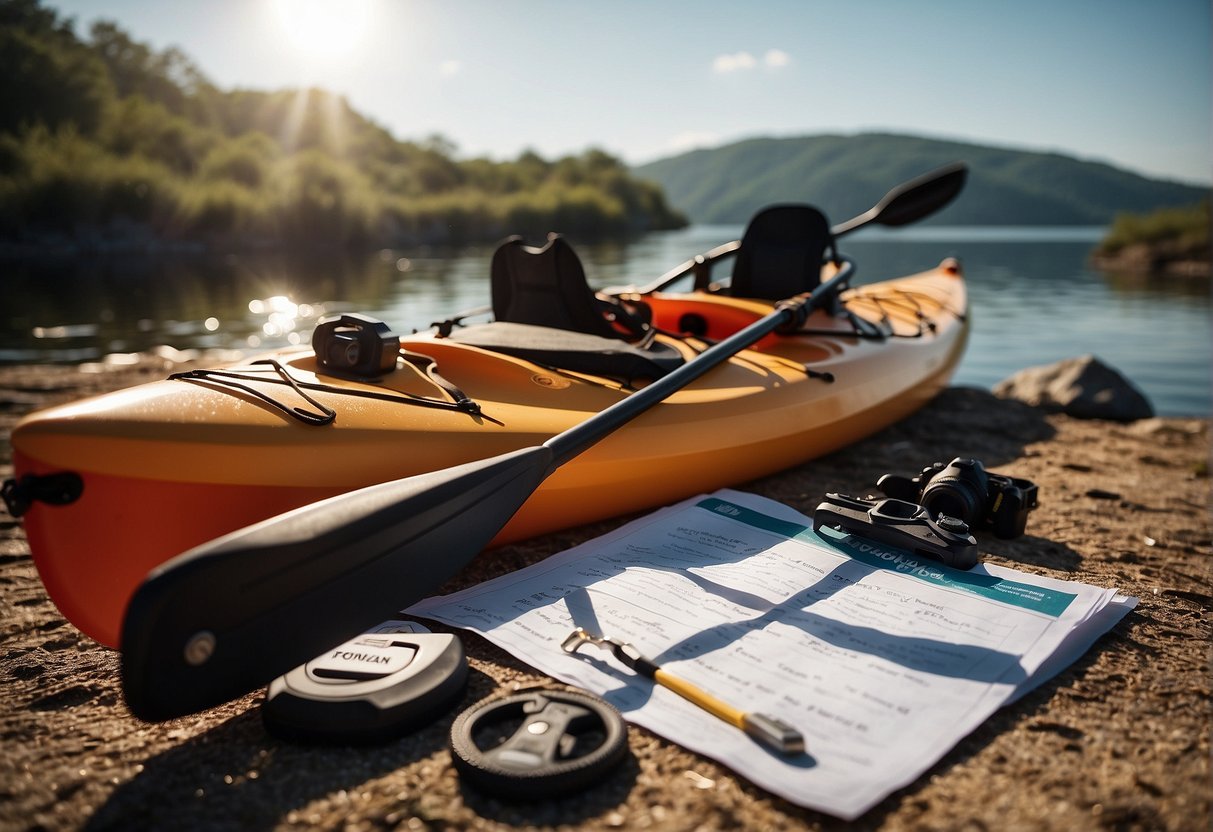
Before you start inspecting your kayak equipment, properly prepare yourself and the inspection area. This includes gathering necessary inspection tools and setting up the inspection area.
Gathering Necessary Inspection Tools
Before you begin the inspection process, list the tools and materials you need for a thorough kayak equipment inspection. Some essential items include:
- Paddle: Ensuring your paddle is in good condition is crucial for a safe and enjoyable kayaking experience.
- Towel: A clean towel helps dry off your equipment and wipe down surfaces during the inspection.
- Sponge: A sponge helps clean any dirt or debris from your kayak and its accessories.
- Clean water: You will need clean water to rinse any dirt or contaminants from your kayak equipment.
- Sun damage check: Inspecting your kayak for sun damage is essential to kayak maintenance, as prolonged exposure to the sun may weaken the kayak material.
- Kayak storage: Proper kayak storage, when not in use, is crucial to prevent damage and ensure it remains in good condition.
Setting up the Inspection Area
Once you have gathered all the necessary tools and materials, you must set up a suitable inspection area. This area should be:
- Well-lit: Ensure the inspection area has adequate lighting to inspect your kayak equipment thoroughly and thoroughly.
- Clean and dry: The inspection area should be free from dirt and moisture to prevent potential damage to your kayak equipment.
- Spacious: Ensure enough space to maneuver and inspect all parts of your kayak safely and comfortably.
By correctly preparing for your kayak equipment inspection, you are setting yourself up for success in maintaining your gear. Proper pre-inspection preparations will make the inspection process more efficient and help you prevent any potential issues from arising during your kayaking adventures.
Personal Gear Inspection
Life Jackets and PFDs
You are inspecting your life jacket or personal flotation device (PFD) before every kayaking trip is essential. Start by examining the fabric and straps for signs of wear, fading, or fraying. If you find any damage, replace the PFD immediately. Also, ensure that the flotation foam is not compressed or damaged, as this can reduce the device’s buoyancy.
Next, check the buckle and zippers to ensure they are working well. You can also test your PFD by putting it on and ensuring it fits snugly without being too tight. Adjust as necessary and float in shallow water to see if the PFD provides adequate buoyancy.
Helmets, Gloves, and Footwear
Helmets are essential to your safety gear, especially while kayaking in rough waters or rocky environments. Inspect your helmet for any cracks, dents, or other signs of damage. Ensure the lining and padding remain intact, and the straps are not frayed or worn. Replace your helmet if you find any issues during the inspection.
Gloves help protect your hands during extended paddling sessions. Check for any holes, worn areas, or fraying seams. Replace your gloves if you find significant wear or tear affecting their performance.
Footwear provides traction and stability while in and out of the kayak. Inspect for any holes or tears in the fabric and excessive wear on the soles. If your footwear no longer provides adequate grip, consider replacing them for a safer kayaking experience.
Do not forget to include a first aid kit in your gear, which should be checked regularly for expiration dates and to replenish any used items. Finally, ensure that all other safety gear, such as signaling devices or rescue equipment, is readily available and in good working condition. Regularly inspecting your gear can make you a safer and more enjoyable time on the water.
Kayak Storage and Transportation
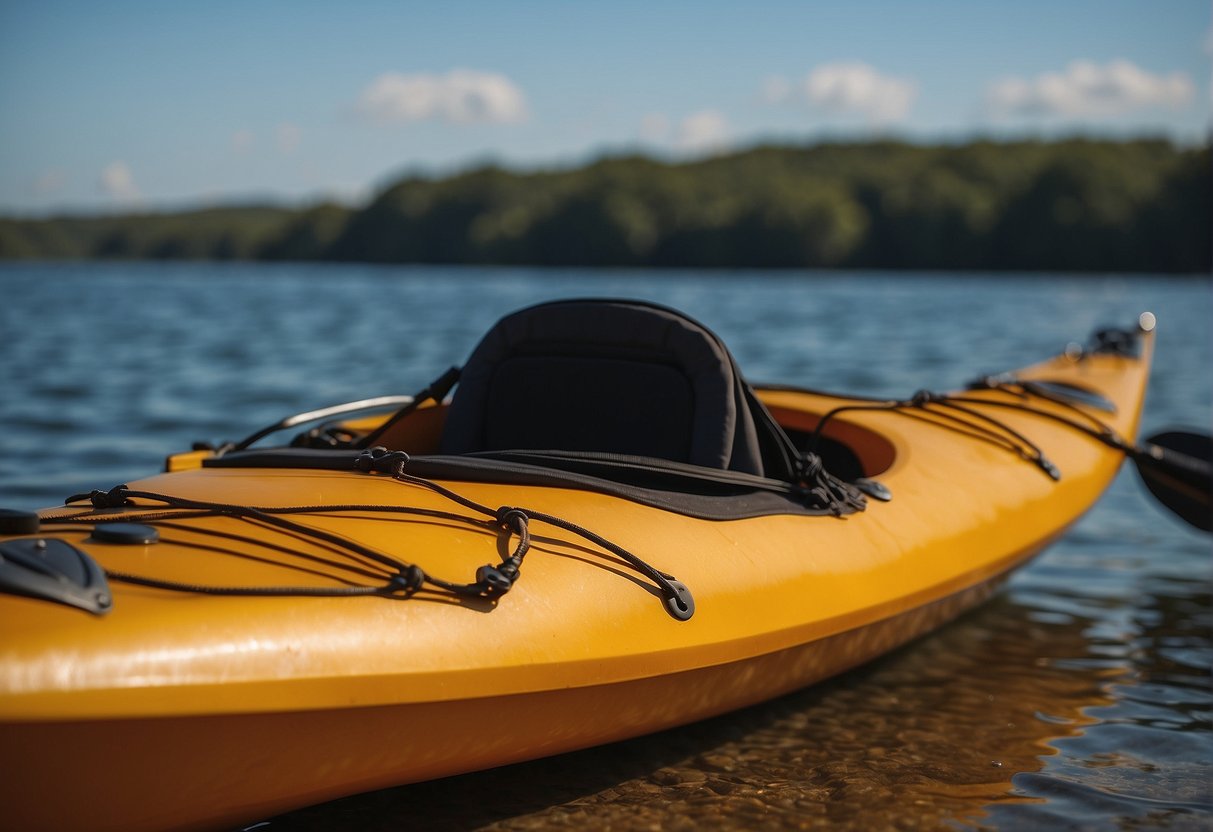
Storing Your Kayak Properly
Proper kayak storage is essential to keep your equipment in excellent condition and prevent damage due to weather elements. First and foremost, clean your kayak with fresh water, especially after it has been exposed to saltwater, to avoid corrosion. Allow it to dry completely before storing it.
Indoor storage is the most effective way to protect your kayak from the elements. If you must store your kayak outdoors, use a kayak cover to protect it from direct sunlight, rain, and snow. Prolonged exposure to UV rays or damp conditions can cause warping and other structural damage.
When storing a kayak, keep it off the ground to avoid any potential distortion. There are various methods to store a kayak, such as using storage racks or hanging storage. These methods not only prevent damage but also save space. Ensure your kayak is secured correctly and accessible from pressure points that may cause warping over time.
Safe Transportation Techniques
Transporting your kayak safely is crucial to avoid any damage during transit. Before loading your kayak onto a vehicle, ensure it is clean and all accessories have been removed. Proper kayak transportation usually requires at least two people to prevent injury or vehicle damage.
Here are some basic steps for safe kayak transportation:
- Secure your kayak: Use reliable straps to attach your kayak to your vehicle’s roof rack or a specialized kayak carrier. Ensure the straps are evenly tightened and the kayak tightly linked to the car.
- Use padding: Protect your vehicle and the kayak from potential damage by placing padding between the kayak and the carrier or roof rack. Foam blocks or specialized pads work well.
- Check your load frequently: Always check the kayak’s position and the security of its attachment during transportation. Stop and adjust the straps to ensure the kayak remains secure if you notice any shifting.
By following the recommended storage and transportation methods, you can maintain the quality of your kayak, extend its life, and ensure safe adventures on the water.
Inspection of Kayak Hull
Checking for Damage
When inspecting the kayak hull, it’s essential to identify any possible damage. Start by examining the hull for superficial scratches, which are common and usually not a cause for concern. However, deeper scratches or cracks can compromise the integrity of the kayak and require attention.
Assess the entire surface of the hull, paying close attention to areas that come into frequent contact with the ground or rocks. This includes the bow and stern, where damage is often more prevalent. It’s also wise to look for any signs of discoloration or fading, as these can indicate prolonged exposure to sunlight and potential UV damage.
Identifying Hull Repairs
Once you have identified any damage, evaluate if it requires immediate attention or professional assistance. You can use a repair kit to patch up the affected areas for minor scratches and dings. Read the manufacturer’s instructions on how to use the kit and follow the recommended procedures closely.
For more extensive damage, such as deep cracks or significant distortions in the hull’s shape, it’s advisable to seek professional help. However, some repairs can be done at home, so assessing the damage carefully and making an informed decision is essential.
To protect your kayak’s hull from further damage, consider using a 303 aerospace protectant. This product is a UV shield and can prevent color fading and material degradation. Apply the protectant following the manufacturer’s guidelines, ensuring that you cover the entire surface of the hull for maximum protection.
In conclusion, regularly inspecting the hull of your kayak is an essential aspect of equipment upkeep. Knowing how to address minor issues and when to seek professional assistance will ensure your kayak’s longevity and performance. Maintain your kayak’s hull by staying vigilant for damage, repairing as necessary, and employing preventative measures like 303 aerospace protectant to keep it in top shape for your paddling adventures.
Deck and Cockpit Assessment

Inspecting Seating and Comfort Features
When inspecting a kayak, it’s essential to assess the seating and comfort features. Begin by examining the seat itself, ensuring it is properly secured and free from damage. Adjust the seat according to the kayaker’s preferences, and check if the backrest provides adequate support.
Additionally, evaluate the footrests for proper positioning and adjustability. Ensure they are firmly attached and can be easily adjusted to accommodate different leg lengths. It’s also crucial to ensure that the footrests are positioned to promote proper paddling posture.
Checking Hatches and Cockpit Coaming
The kayak’s hatches also require close inspection. Confirm that the hatch covers are intact, have a good seal, and function correctly. Check for any cracks or signs of wear in the hatch cover and surrounding area. Consider replacing or repairing the hatch cover before your next kayaking adventure if any issues are detected.
Inspect the cockpit coaming, paying particular attention to its condition and shape. The cockpit coaming should be free from cracks or damage and securely fit around the cockpit’s perimeter. Make sure the decking material is in good condition, as well.
Finally, remember that a well-maintained kayak with properly assessed and functioning equipment can lead to a more enjoyable and safer paddling experience.
Paddles and Steering Mechanisms

Paddle Maintenance
Regular inspection and maintenance of your paddles are crucial for maximizing their performance and lifespan. Start by examining the paddle blades for signs of wear, such as cracks or chips. Apply a UV-protective spray to both sides of the blades to protect them from sun damage. After every use, cleaning the paddles, especially the ferrule of a two-piece paddle, helps keep them in optimal condition. If you have an adjustable paddle, ensure the locking mechanism is in good working order and debris-free. Don’t forget to have a spare paddle along during your excursions, as it can be a lifesaver in case your primary paddle gets damaged or lost.
*Examine blade for wear *Apply UV-protective spray *Clean ferrule and locking mechanism *Bring a spare paddle
Rudder and Skeg Inspection
The rudder and skeg play an essential role in the steering and tracking of a kayak. Make sure that the rudder moves smoothly and freely without any obstructions. If you notice any stiffness or difficulty in movement, lubricate the rudder’s pivot points.
For skeg inspection, ensure that the skeg cable and the skeg are in good condition. If the skeg appears stuck or is not operating correctly, it might be due to debris in the skeg box or issues with the cable. In such cases, cleaning the skeg box and ensuring the cable moves freely is essential.
*Inspect rudder movement *Lubricate pivot points *Check skeg and cable *Clean the skeg box
By adhering to this routine inspection and maintenance of paddles and steering mechanisms, kayak enthusiasts can ensure a smooth and safe kayaking experience. Remember to frequently check your paddle, rudder, and skeg for signs of wear or damage, and take the necessary steps to keep them in top condition.
Safety Gear and Accessories
Essential Safety Equipment
Regarding kayaking, ensuring proper inspection and maintenance of safety equipment is crucial for a secure and enjoyable experience. Some essential safety gear that should be routinely inspected include:
- Personal Flotation Devices (PFDs): Always wear a PFD while kayaking. Inspect for signs of wear, tears, and buoyancy loss. Ensure proper fit and functionality.
- Bilge Pump: A critical tool for removing water from the kayak, a bilge pump should be inspected for damage and tested for performance before each use.
- Paddle Float: This self-rescue device provides extra flotation during a wet exit. Check for tears, holes, and inflation efficiency.
- Whistle: A vital signaling device for emergencies, a whistle should be easily accessible and inspected for functionality.
- Tow Line: Inspect the tow line for fraying, damage, and strength, as it is crucial for towing a kayak in emergencies.
Additional Accessories for Convenience
Apart from the essential safety items, many additional accessories can enhance one’s kayaking experience. Some of these items are:
- Dry Bag: A dry bag is an important accessory that keeps personal belongings and essential equipment dry. Inspect it for wear and sealing effectiveness.
- Protective Clothing: Depending on the kayaking conditions, wearing appropriate clothing like wetsuits, drysuits, or other water-resistant garments is essential. Inspect for tears, wear, and functionality.
- Spray Skirt: Useful for preventing water from entering the kayak, a spray skirt should be inspected for wear, tear, and fit.
- Navigation Tools: Check for the functionality and charge of electronic devices such as GPS units, smartphones, and walkie-talkies. Having a waterproof map as a backup is also a good idea.
To ensure a safe kayaking trip, always thoroughly inspect the essential safety gear and consider carrying additional accessories for added convenience. Regular maintenance and care of the equipment can enhance overall safety and performance during kayaking.
Kayaking in Different Water Environments
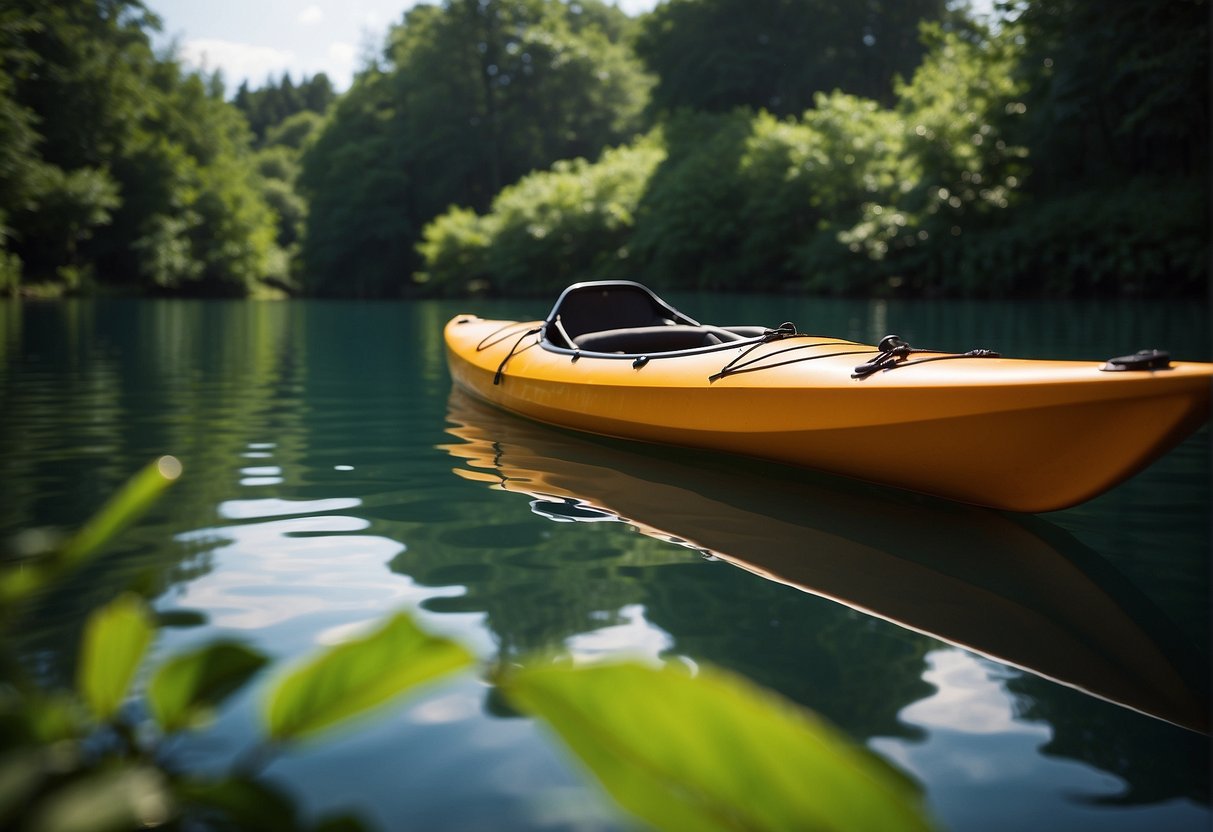
Freshwater Versus Saltwater Considerations
When preparing for a kayaking adventure, it’s essential to understand the differences between freshwater and saltwater environments. While both offer unique kayaking experiences, they require specific gear and inspection procedures to ensure safety and optimal performance.
Water levels and currents can vary depending on the season, rainfall, and local geography in freshwater environments, such as lakes, ponds, and rivers. Assessing the water levels and understanding how the weather and water conditions can affect your kayaking experience is essential. For example, lower water levels can lead to shallow areas or exposed rocks, while higher levels can reduce the clearance under bridges.
On the other hand, saltwater environments, such as oceans and seas, introduce additional factors, including tides, waves, and potentially corrosive elements. When kayaking in saltwater, checking the weather forecast, ocean conditions, and tides before heading out is crucial. Be prepared for changing conditions, and be aware of the area’s marine life and boat traffic.
Critical Considerations in Different Water Environments:
- Freshwater: water levels, currents, and weather conditions
- Saltwater: tides, waves, ocean conditions, and marine life
Inspection for River and Ocean Kayaking
Regardless of the water environment you choose, proper kayak equipment inspection is a vital step before beginning your adventure. However, the nature of the specific environment may require different inspection criteria.
For river kayaking, pay close attention to the following:
- Personal Flotation Devices (PFDs): Ensure that the PFD fits securely and is properly adjusted. Remember, always wear a PFD.
- Helmets: Helmets are crucial for river kayaking, especially in whitewater or rocky sections. Check the helmet for cracks and proper fit.
- Paddles: Inspect the paddles for damage or wear and ensure they suit river conditions.
In ocean kayaking, consider the following during your equipment inspection:
- PFDs: As in river kayaking, always wear a PFD. Choose one with a whistle or other signaling devices for open water use.
- Marine Communication Devices: Carry a marine radio or GPS device for emergencies and navigation assistance.
- Bilge Pumps and Floatation: Confirm your kayak has proper flotation devices, and don’t forget a bilge pump to remove water in the event of a capsize.
Remember that the most crucial aspect of equipment inspection is understanding how these factors change due to the specific water environment and ensuring your gear suits the planned adventure.
Seasonal and Weather Considerations
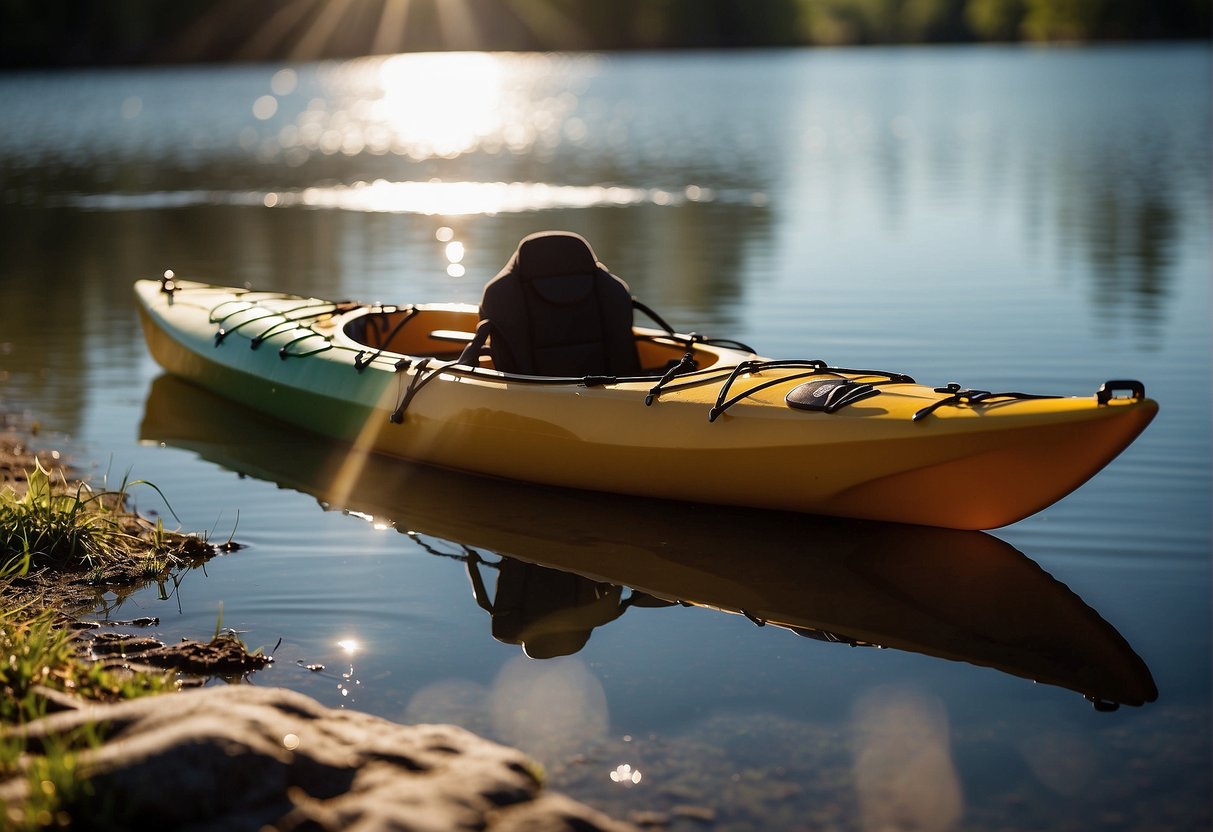
Preparing for Weather Changes
Proper kayak equipment inspection does not only rely on checking the gear but also considering the weather conditions. When planning your kayaking trip, it’s essential to check the weather forecast in advance. Be mindful of potential storms, strong winds, and temperature changes that may affect your experience.
To protect your kayak from sun damage, store it away from direct sunlight when not in use. A good kayak cover or tarp can keep the sun off and prevent unwanted critters and insects from using it as a new home. Regular rinses with fresh water after use, especially in saltwater, will help prevent corrosion and keep your kayak in good condition. Remember to handle your kayak gently to avoid strain or damage.
Kayaking in Cold and Warm Conditions
Cold Water: Kayaking in cold water requires extra caution as it can increase the risk of hypothermia. Ensure you have appropriate gear, such as dry suits, gloves, and boots, to keep you warm and dry. Consider practicing T-rescues and other safety techniques in a controlled environment to enhance your confidence and skill in cold water kayaking. Planning your arduous weather trip thoroughly and knowing your limitations will help you have a safer and more enjoyable experience.
- Drysuits
- Gloves
- Boots
Warm Weather: In warmer conditions, protecting yourself from the sun’s harmful effects is crucial. Wear sun-protective clothing, such as hats, sunglasses, and long-sleeved shirts with UPF protection. Staying hydrated is essential, so don’t forget to bring enough water to keep you going during the trip. While paddling, note signs indicating that the weather might change, such as cloud formations or increasing winds.
You can ensure a safe and enjoyable kayaking adventure by thoroughly inspecting your kayak equipment and considering the seasonal and weather conditions.
Maintenance Schedule and Records
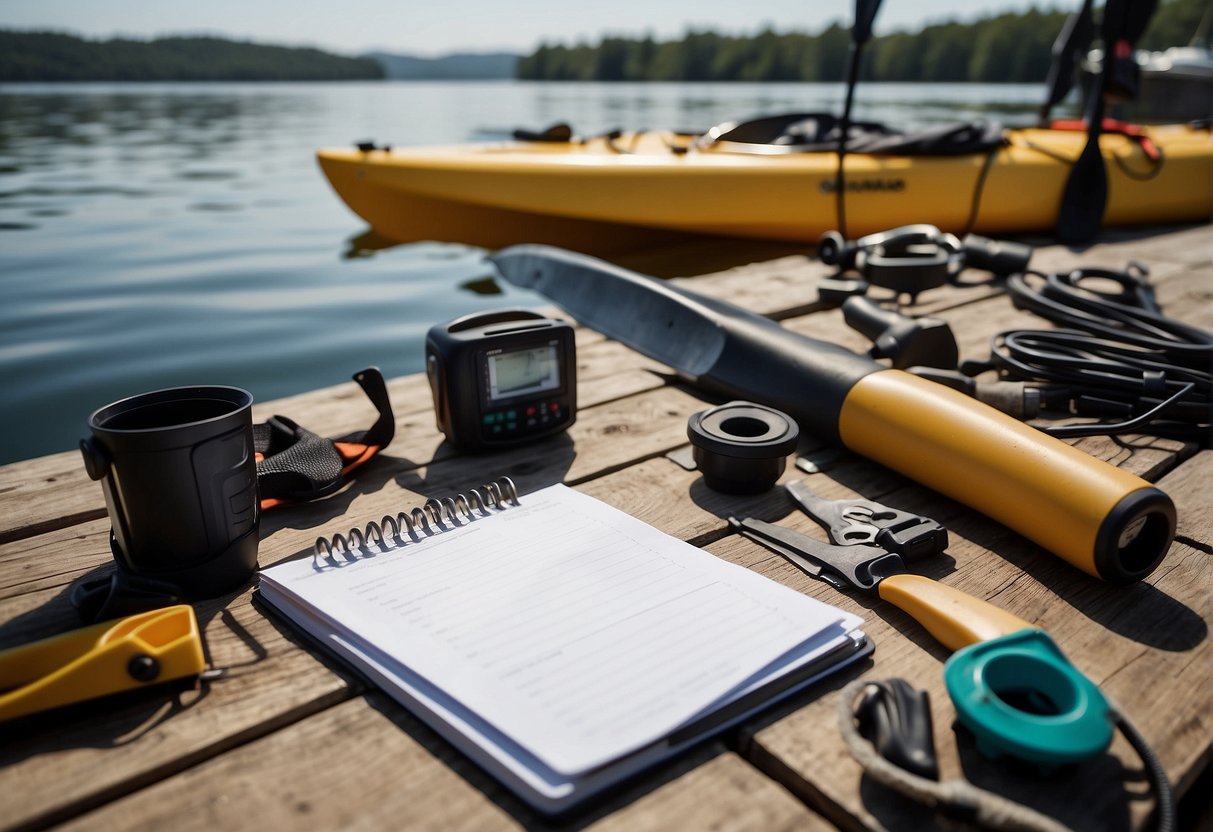
Routine Kayak Maintenance
A well-maintained kayak ensures safe and enjoyable paddling experiences. Establishing a routine kayak maintenance schedule is a great way to preserve the lifespan of your kayak and its equipment. Here are some essential steps for proper kayak maintenance:
- Cleaning: Regularly clean your kayak with fresh water, especially after each use in saltwater. This prevents salt buildup and minimizes long-term damage to the kayak’s material.
- Inspection: Examine the hull, deck, and seams for any damages or wear and tear. Repair or replace as necessary.
- Hardware Check: Inspect the kayak’s hardware, such as footpegs, rudders, and skegs, for signs of excessive wear, corrosion, or malfunction. Tighten any loose screws and lubricate moving parts as needed.
- UV Protection: Apply a UV protectant spray to prevent the kayak’s color from fading and the material from becoming brittle due to sun exposure.
- Proper Storage: When not in use, store your kayak in a dry, covered area and off the ground to avoid direct contact with moisture. Consider using a kayak cover for additional protection.
Logging Repairs and Inspections
Keeping track of your kayak’s maintenance history is as important as giving it TLC. It will help you plan future inspections, detect recurring issues, and maintain the kayak’s resale value. Here are some tips for logging repairs and inspections:
- Create a maintenance logbook to record all maintenance tasks, repairs, and inspections. Include the date, description of the task, and any notes about the kayak’s condition or parts replaced.
- Use a standardized inspection checklist to ensure you consistently cover all essential aspects of the kayak during an inspection.
- Keep track of the manufacturer’s recommendations regarding maintenance intervals and requirements for specific kayak parts. Incorporate these guidelines into your routine maintenance schedule.
- Store all receipts and warranties for any repairs or replaced equipment safely and organized. This documentation will be helpful for a warranty claim or future resale.
By adhering to a consistent maintenance schedule and accurate records, you can ensure your kayak remains in optimal condition and enjoy a safer, more enjoyable paddling experience.
Emergency Repairs and Kits
Assembling Your Repair Kit
When preparing for a kayaking adventure, it’s crucial to have a well-organized repair kit. A good repair kit will contain essential items such as a first aid kit, waterproof tape for patching small holes, and a compact multi-tool for adjusting your kayak. Additionally, alcohol wipes are included for cleaning surfaces before applying any adhesive materials. Store these items in a waterproof pouch for easy access and protection from water damage.
- First Aid Kit
- Waterproof Tape
- Multi-Tool
- Alcohol Wipes
- Waterproof Pouch
Aside from these essentials, consider adding a small flashlight for illuminating dark areas during repairs. To tackle more complex maintenance, include a small tube of marine-grade adhesive, which can seal leaks and reattach separated components. Don’t forget to pack a paddle leash and a spare carabiner for various uses, as mentioned in this paddling.com article.
On-Water Repair Solutions
In addition to assembling a proper repair kit, it’s crucial to have on-hand solutions for common issues that may arise while kayaking. For example, if you encounter a leak in your kayak, quickly assess the situation and determine whether it can be temporarily fixed using the waterproof tape in your repair kit. If the damage is more severe and requires immediate on-water attention, refer to your marine-grade adhesive for a temporary but durable solution.
Another common on-water issue is paddle-related problems. In such cases, a paddle leash comes in handy, preventing you from losing your paddle and ensuring you can continue paddling even with a damaged one.
Please familiarize yourself with the contents of your repair kit and practice using them in various scenarios to gain confidence in handling potential on-water situations. Doing so will prepare you to handle emergencies and ensure a safer, more enjoyable kayaking experience.
Handling and Performance Checks
Testing Kayak Balance and Maneuverability
Proper handling is crucial for any kayaker, regardless of experience level. Start by examining the kayak on flat water to test its balance and maneuverability. Paddle forward, backward, and sideways, and attempt to turn the kayak in different directions. Observe how the kayak responds to your movements and ensure that it is stable, easy to control, and adjusts smoothly to changes in direction.
It’s essential to inspect your kayak’s ability for self-rescue. Try executing various rescue techniques like the T-rescue, wet exit, and re-entry during your test paddle. This helps you understand the kayak’s reaction during emergencies while ensuring you’re well-prepared for potential on-water situations.
Assessing Limitations and Challenges
Different kayak types are designed to handle varying paddling conditions, which means each comes with specific limitations and challenges. In this section, you’ll learn how to assess your kayak’s limitations and challenges related to handling, limits, and safety.
- Handling: Evaluate the kayak’s tracking ability – how well it maintains a straight course when paddling. Check if it’s easily affected by wind or currents and if the rudder or skeg is functioning correctly for better control2.
- Limits: Understand the conditions for which your kayak is designed. For example, if you have a recreational or touring kayak, it may not perform optimally in whitewater or extreme conditions. Familiarize yourself with the kayak’s limitations to avoid venturing into risky situations.
- Challenges: Be mindful of potential challenges that affect kayak safety. This includes the presence of obstacles, changing weather conditions, and water currents4. Consider whether your skill level suits the paddling environment and adapt your approach accordingly.
By evaluating your kayak’s balance, maneuverability, limitations, and challenges, you’re ensuring a safe and enjoyable experience on the water. Regular inspection and maintenance of your kayak and its safety equipment contribute to optimal performance and longevity.
Footnotes
Technological Aids and Communication
Utilizing GPS and Navigation Tools
GPS technology has become an invaluable asset for kayakers, ensuring safe and efficient navigation while out on the water. Popular GPS devices for kayaking are equipped with features to help beginners and experienced paddlers. Essential features include accurate location identification, water-resistant components, and easy-to-read screens. Apart from dedicated GPS devices, many smartphone apps are available that can aid kayakers in navigation. Still, keeping your phone secure in a waterproof pouch while using such apps is crucial to avoid damage.
In addition, it’s essential to pay close attention to local weather and water conditions, including moving water, which can pose challenges and hazards. Adequate preparation and regular monitoring of these conditions can help prevent potential difficulties or dangers while kayaking.
Emergency Communication Devices
Communication plays a crucial role in ensuring a safe and enjoyable kayaking experience. Equip yourself with a reliable communication device like a VHF radio that allows for real-time contact with nearby vessels and emergency services. These radios often come with built-in weather and alert capabilities to keep you updated on any changes in conditions while on the water.
A backup communication device, such as a whistle, which can signal distress or alert other kayakers to your presence, is also recommended. Don’t forget to carry additional essential items like snacks to maintain energy levels during long excursions. Remember to keep all communication tools and emergency supplies in a waterproof pouch or container for easy access and protection from water damage.
Remember that technology and communication devices are valuable for navigating and ensuring safety during kayaking. Utilize these tools wisely and know how to operate them correctly to have the most enjoyable experience on the water.
Frequently Asked Questions
What steps should be taken to inspect the condition of a kayak before use?
Before using a kayak, ensure it is clean and free from any dirt or debris affecting its performance. Examine the hull for cracks, dents, or holes, and check the seams for any signs of weakness. Inspect the handles and deck rigging for wear and secure attachment. In addition, make sure that the kayak’s seat is in good condition and that the footrests work correctly. All hatches should be checked to ensure they create a watertight seal.
Which materials are best suited for kayaking apparel to ensure safety and comfort during a trip?
Choose clothing from breathable, quick-drying materials like polyester, polypropylene, or neoprene. For protection from wind and water, consider wearing a waterproof shell made from materials like Gore-Tex or eVent. It is also essential to dress in layers, which can be adjusted according to changes in temperature or activity level during the trip.
What are the mandatory safety items one must have when embarking on a kayaking adventure?
Always carry a personal flotation device (PFD) for each person on board, a bilge pump or sponge for removing water from the kayak, a paddle float, a whistle for signaling, a well-stocked first-aid kit, and a spare paddle. In addition, consider bringing a waterproof flashlight with extra batteries, a compass, and a map or GPS device for navigation.
What essential gear should paddlers always include in their kayaking preparation checklist?
Some essential items for kayaking include a properly fitting PFD, a paddle, dry bags for storing belongings, clothing appropriate for the weather and water conditions, sunscreen, sunglasses, and a hat for sun protection. Additionally, include a well-stocked first-aid kit, a rescue throw bag, a waterproof flashlight, a knife or multi-tool, extra snacks and water, and a signaling device such as a whistle or flare.
How can one assess the need for permits or special requirements when planning to kayak in a new location?
Check the regulations and guidelines of each specific location by researching online or contacting local authorities or park management. Permits may be required to access certain waterways, overnight camping, or launching kayaks. Some areas may also have specific guidelines for group sizes, wildlife interaction, or seasonal closures. Always abide by these rules to ensure a safe and enjoyable kayaking experience.
Are there specific techniques for evaluating the structural integrity of paddles and other kayaking accessories?
Inspect the paddle for any cracks, dents, warping, or signs of excessive wear. Check that the joints are secure and that the ferrule (the connector between paddle halves) functions correctly. For other accessories, such as helmets or spray skirts, examine them for signs of damage or excessive wear, ensuring that all straps and buckles are functional and in good condition. Replace any damaged or worn equipment as necessary to ensure safety and performance on the water.
Conclusion
Proper kayak equipment inspection is vital to ensure the longevity of your gear and, more importantly, to guarantee your safety on the water. Regularly checking your equipment minimizes the risk of accidents and maximizes your enjoyment of this exciting outdoor activity.
First and foremost, always inspect your kayak before and after every trip. Check for any signs of damage, cracks, or stress points on the hull or deck. Additionally, moving parts, such as foot pegs, should be cleaned and maintained frequently to remain functional.
Regarding your paddle, take the time to disassemble and clean the joints thoroughly. Ensuring that your paddle remains in optimal condition will enhance your kayaking experience. Don’t forget to examine personal flotation devices, helmets, and other safety equipment to ensure that they are in proper working order and well-adjusted for your use.
Finally, remember that kayaking safety is crucial to participating in this outdoor sport. Stay up-to-date with weather and water conditions before heading out, and always carry appropriate gear for the kayaking you’ll be doing. By inspecting and maintaining your equipment regularly, you’ll be better prepared to enjoy a safe and enjoyable kayaking adventure.





